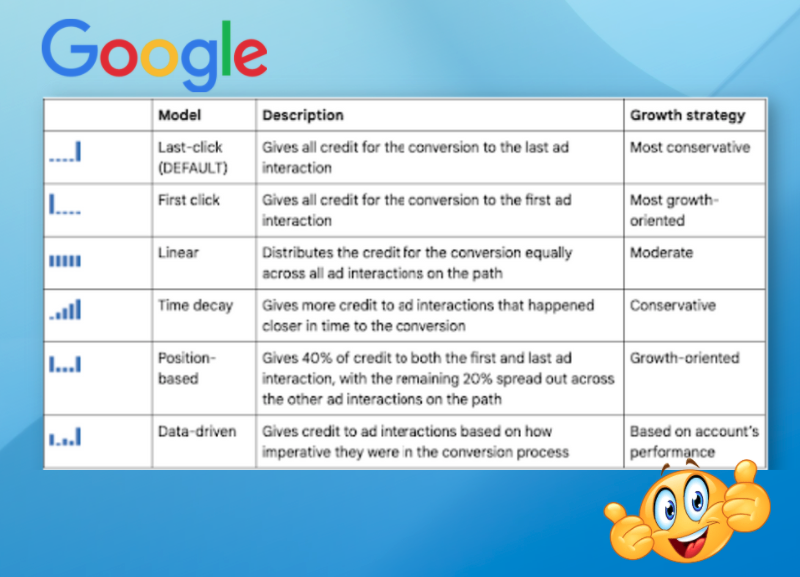It’s that time of year again—time to collect and assess everything we learned in 2021 so we can more effectively strategize how we can maximize our impact as the new year approaches.
Reviewing those final results (below the surface) and doubling down on what worked reveals a goldmine of data. It is in this vortex of complex metrics that we can begin to unlock real opportunities for growth by truly understanding what strategies and campaigns were victorious—and which were not.
Welcome to the world of success attribution.
While you have likely heard the term “attribution model” from heavy hitters like Google, too often the “models” presented by these ad platforms are overly simplistic and borderline unreliable. Why? Because ad platforms like Google and Facebook want to ensure that every scrap of success can be attributed to them—and only them—so this is where advertisers will stay focused.
Here is an example of your attribution model options from Google.

So, what do all of these attribution models have in common? No matter which one you pick, Google is going to get the credit. After all, this is their ad platform.
But what about all the other touchpoints your customers experience between (maybe) seeing an ad and making a purchase?! (Think: the customers who visited your site, saw you on Amazon, received your emails, came back to your site, then saw your Facebook remarketing ad.) The vast majority of the time, the path to purchasing is never a direct line from one ad to one click to one purchase.
It’s time to focus on real success attribution when it comes to your 2022 digital marketing strategy.
Know Your Touchpoints
 At the highest levels, you should take stock of every marketing touchpoint you are investing either time or cash in. Here is a snapshot of what this might look like:
At the highest levels, you should take stock of every marketing touchpoint you are investing either time or cash in. Here is a snapshot of what this might look like:
- Your business’s website
- Google Ads campaigns
- Social media campaigns (paid and organic)
- Emails & SMS text messaging
- Your Amazon product listings
Each one of these channels has its own internal touchpoints—and the strategies that got you to these touchpoints—to consider. And each offers specific data you can drill down into. Consider where each of your touchpoints falls along the customer journey—from initial awareness and consideration to conversion and loyalty.
In order to attribute success, you need to know where to look and how the big picture is connected. Should each of your touchpoints have equal weight when it comes to attributing success? No way. But should each be adding fuel to success, sales, and conversions? Absolutely.
Track Everything
![]() To properly attribute success to each of your marketing channels, you must track everything that can be tracked—and not just final results. You need to follow and consider the entire pathway that helped you achieve those final results.
To properly attribute success to each of your marketing channels, you must track everything that can be tracked—and not just final results. You need to follow and consider the entire pathway that helped you achieve those final results.
When you are able to correlate success to customer actions, you can not only attribute success more accurately, you can also optimize your time and marketing investment in a more fruitful manner in 2022 and beyond.
Here are some metrics you must be tracking to properly attribute success:
Website traffic and conversions
Use Google Analytics and always look at quarterly and annual traffic trends. Ensure that you have goals in place to properly track micro and macro conversions.
Paid campaign impact and conversions
Whether you’re working with an agency or not, you must have complete access to your paid media campaign metrics—both current and historical. Look at seasonality, devices, audiences, etc.—every one of these metrics will help you attribute success. It is not just the channel you should care about but what specifically within that channel is moving the needle.
Lead tracking
![]() Every phone call, SMS message, email, website form, landing page, etc. must be tracked. No sale magically appears. It came from somewhere. Every successful conversion needs to be tied to previous actions. After all, these are the breadcrumbs customers are following to your business. You want to pinpoint the tasty trail your customers seem to prefer.
Every phone call, SMS message, email, website form, landing page, etc. must be tracked. No sale magically appears. It came from somewhere. Every successful conversion needs to be tied to previous actions. After all, these are the breadcrumbs customers are following to your business. You want to pinpoint the tasty trail your customers seem to prefer.
Keep in mind that you’re rarely going to find all this data, wrapped with a nice little bow, in one place.
Your Google Ads, Facebook Ads, and Amazon accounts will have your paid media data metrics. Your CRM and email marketing platform will have others.
So, at the end of the day make sure you have access to everything you need. If you are working with an agency that is gating any of your data—demand access. If they will not provide it, it may be time to find a new agency that will.
Understand Your User Experience
 Live session recording and heatmaps are invaluable tools. If you want to dig into the problem pages you find using Google Analytics, consider a tool like National Positions Conversion Growth Pack to get a better understanding of your customers’ actions on your site.
Live session recording and heatmaps are invaluable tools. If you want to dig into the problem pages you find using Google Analytics, consider a tool like National Positions Conversion Growth Pack to get a better understanding of your customers’ actions on your site.
If you want to attribute success to your website (during the nurturing part of the journey, for example), then the data provided with heatmaps and live site session recordings should support this.
Remember, not only do you want to be able to properly attribute success, you also want to understand how to improve your weak spots.
Google Analytics data can tell you how much success you can attribute to your site (the “what”), but it can’t tell you the “why.” Using a solution like the aforementioned site tracking tool can help you peel back the layers and understand what you need to do to improve.
Understand the Customer Journey
 The huge nut you are looking to crack (when it comes to attributing success) is where along the customer journey you can speed up the conversion process. So being able to attribute success to specific parts of your customer journey is also critical.
The huge nut you are looking to crack (when it comes to attributing success) is where along the customer journey you can speed up the conversion process. So being able to attribute success to specific parts of your customer journey is also critical.
For example, if you are getting a decent amount of website leads but few conversions after the fact, nurturing these leads may need help. Alternatively, if you are only getting a few web leads but your follow-up emails are successfully converting half of these to appointments, phone calls, or sales—the issue may be with your website.
There are a thousand ways to look at this, but boiling it down to the key points in the customer journey will help you understand where you need to focus your efforts.
Top of funnel – Are you driving attention and interest via your website, paid media, and ecommerce product placement? What impact is it having? In other words, are they finding you and are you enticing them?
Mid-funnel – Are you keeping top of mind with interested customers via remarketing, email nurturing and personalization of their experience? In other words, are you making sure they don’t forget about you?
Bottom of funnel – Where and how are customers converting? Are they coming back to your site, responding to abandoned cart emails, or buying directly from Amazon? In other words, what is inspiring them to make that final decision and from where do they prefer purchasing?
Understanding the Big Picture
 Being able to attribute success across your marketing channels is not about patting yourself on the back—it is about humbly uncovering your weak spots. If you know what is broken, you know what needs to be fixed. It is not enough to see final sales numbers and make a snap decision, and without knowing your metrics you can end up making assumptions.
Being able to attribute success across your marketing channels is not about patting yourself on the back—it is about humbly uncovering your weak spots. If you know what is broken, you know what needs to be fixed. It is not enough to see final sales numbers and make a snap decision, and without knowing your metrics you can end up making assumptions.
Attribution may be one of the most difficult puzzles to assemble, but once the pieces are in place you can clearly see the big picture. Getting the ball rolling will unearth answers to so many questions (and bring up new questions) that are essential to building a better strategy.
We want nothing but the best for your business in the new year, so if you want to give yourself a major advantage in 2022, start considering all of these success attribution ideas today. If you need a little (or a lot of) help, our team is always available to assist and eager to partner with your brand. You can contact our team directly at (818) 918-5188 or send us an email using this link.